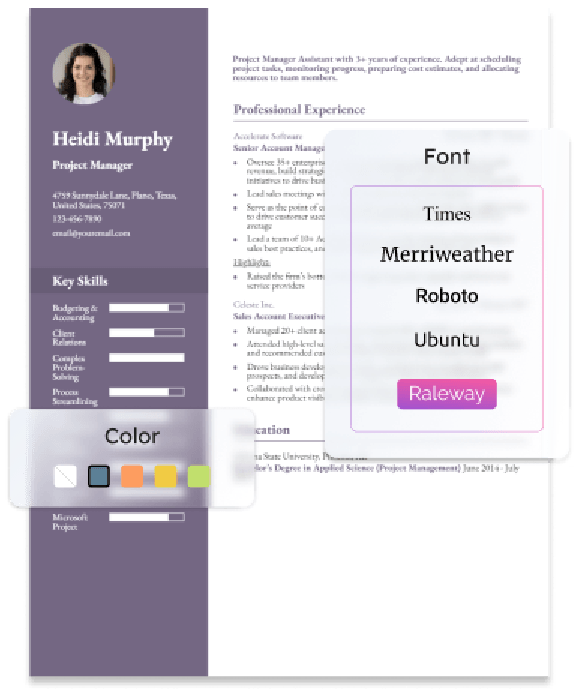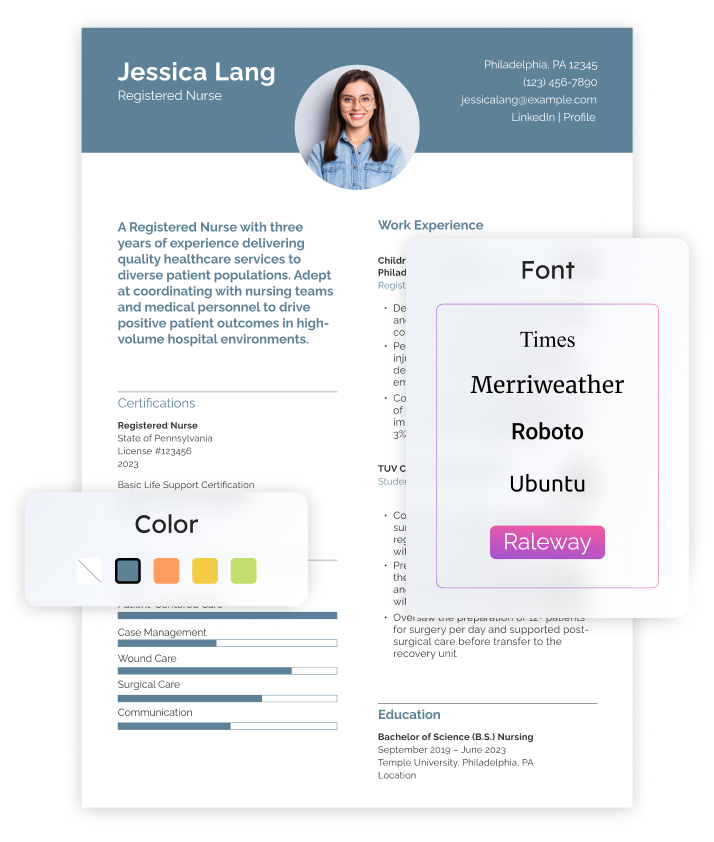To write a strong, accomplishment-driven nurse practitioner resume, detail your most compelling achievements within the health care space. Hiring managers want a better understanding of who you are as a professional, and the best way to accomplish this is by telling your own unique story.
For example, if you’re interested in pursuing a career within the mental health sector, highlight your approach to treating patient symptoms for specific disorders. Did you use evidence-based treatment modules? How successful were you in reducing depressive symptoms across your practice? By providing insights to showcase the nuances of your health care experiences, you’ll differentiate yourself from the competition during your job search. We’ll provide various expert tips to help you build your resume and advance your career.
“Nurse practitioner resumes should focus on advanced clinical skills, patient outcomes, and leadership in care delivery. Your resume should reflect both expertise and empathy. ”
— Carolyn Kleiman, Resume and Career Advisor
Most Popular Nurse Practitioner Resumes
Entry-Level Nurse Practitioner Resume
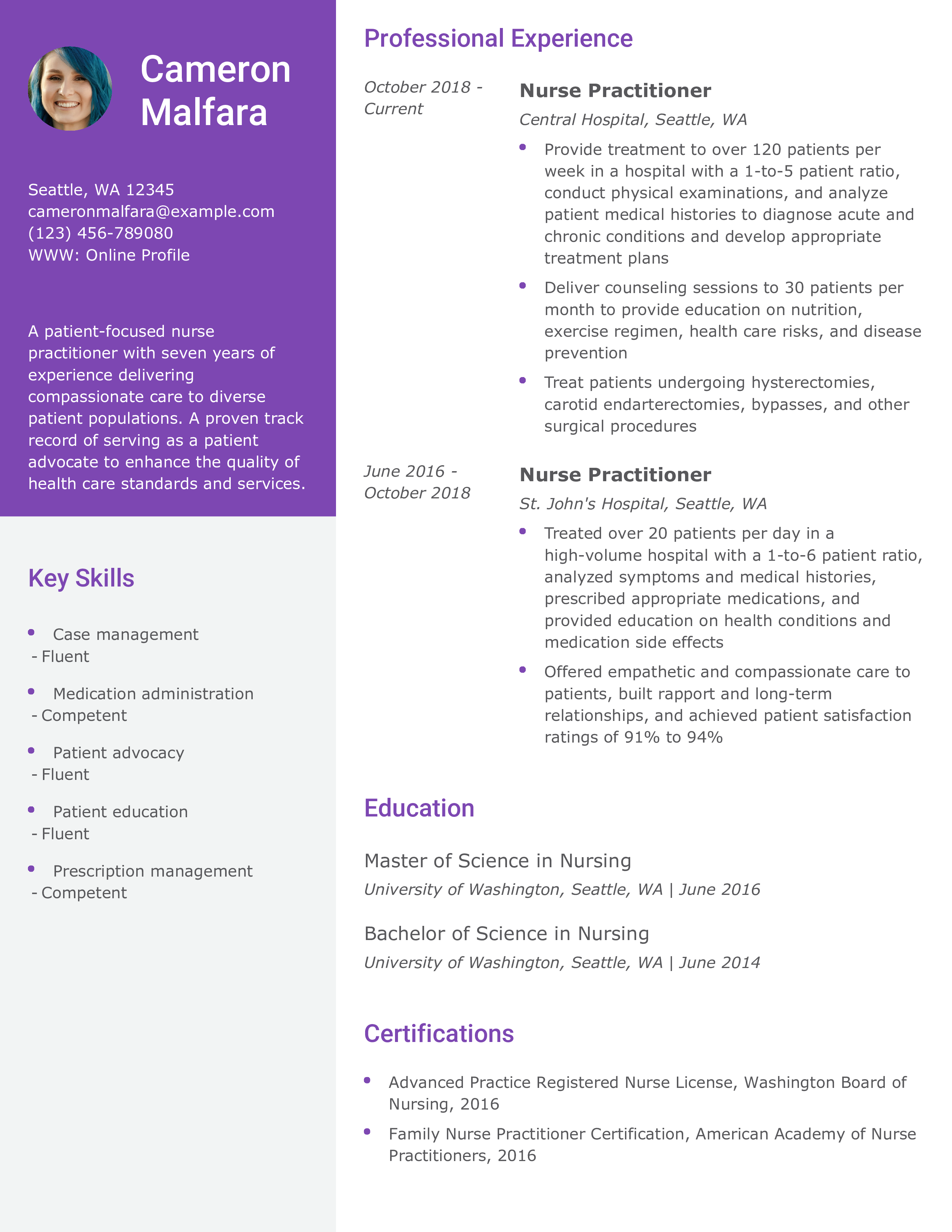
Why this nurse practitioner resume example is strong:
This example of a nurse practitioner resume summarizes the candidate’s career and uses concrete statistics to illustrate their work experience, patient load, and patient satisfaction rates.
Experienced Nurse Practitioner Resume
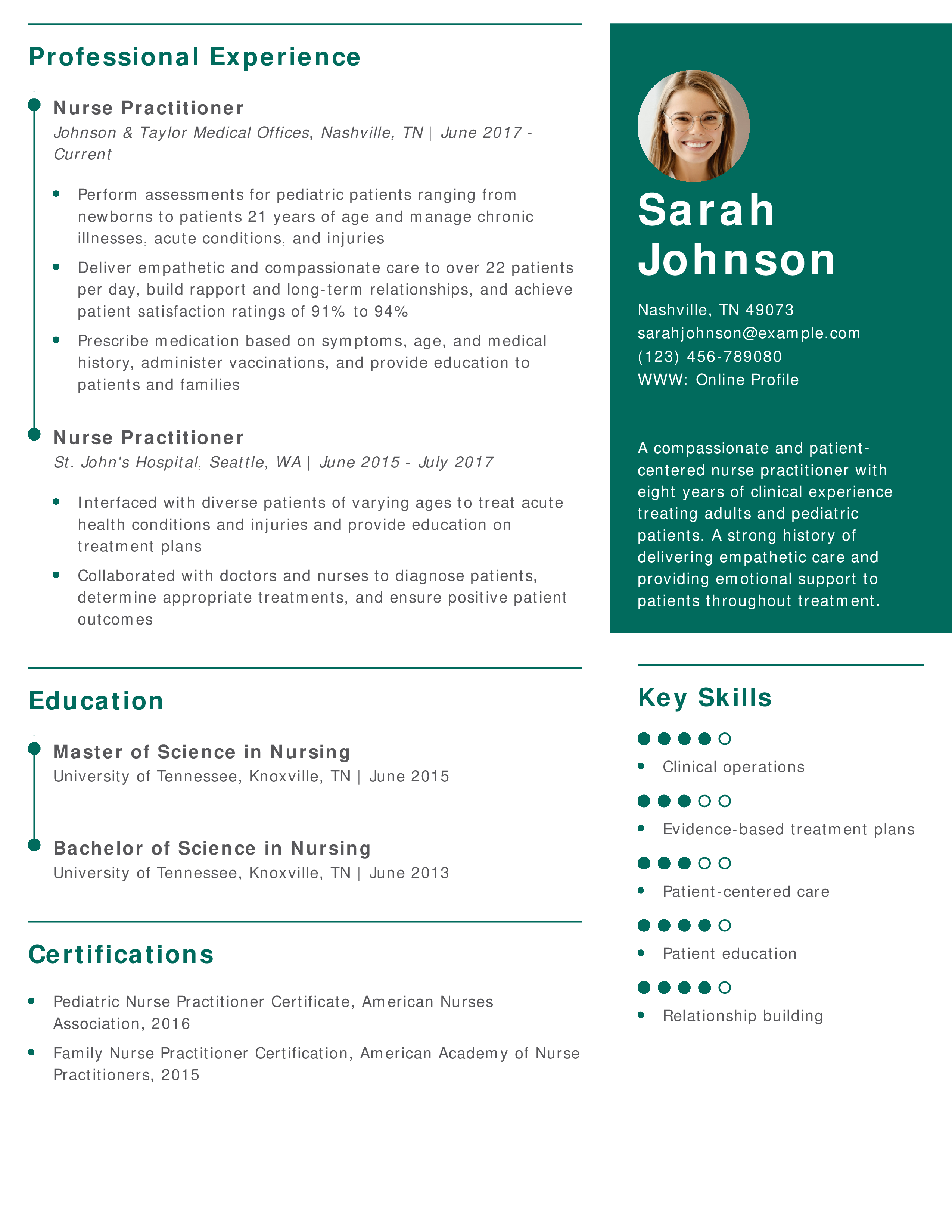
Why this nurse practitioner resume example is strong:
In addition to statistics about patient satisfaction, this nurse practitioner resume includes keywords such as “patient-centered” and “compassionate” to indicate the candidate’s bedside manner alongside their skills and qualifications.
Senior Nurse Practitioner Resume
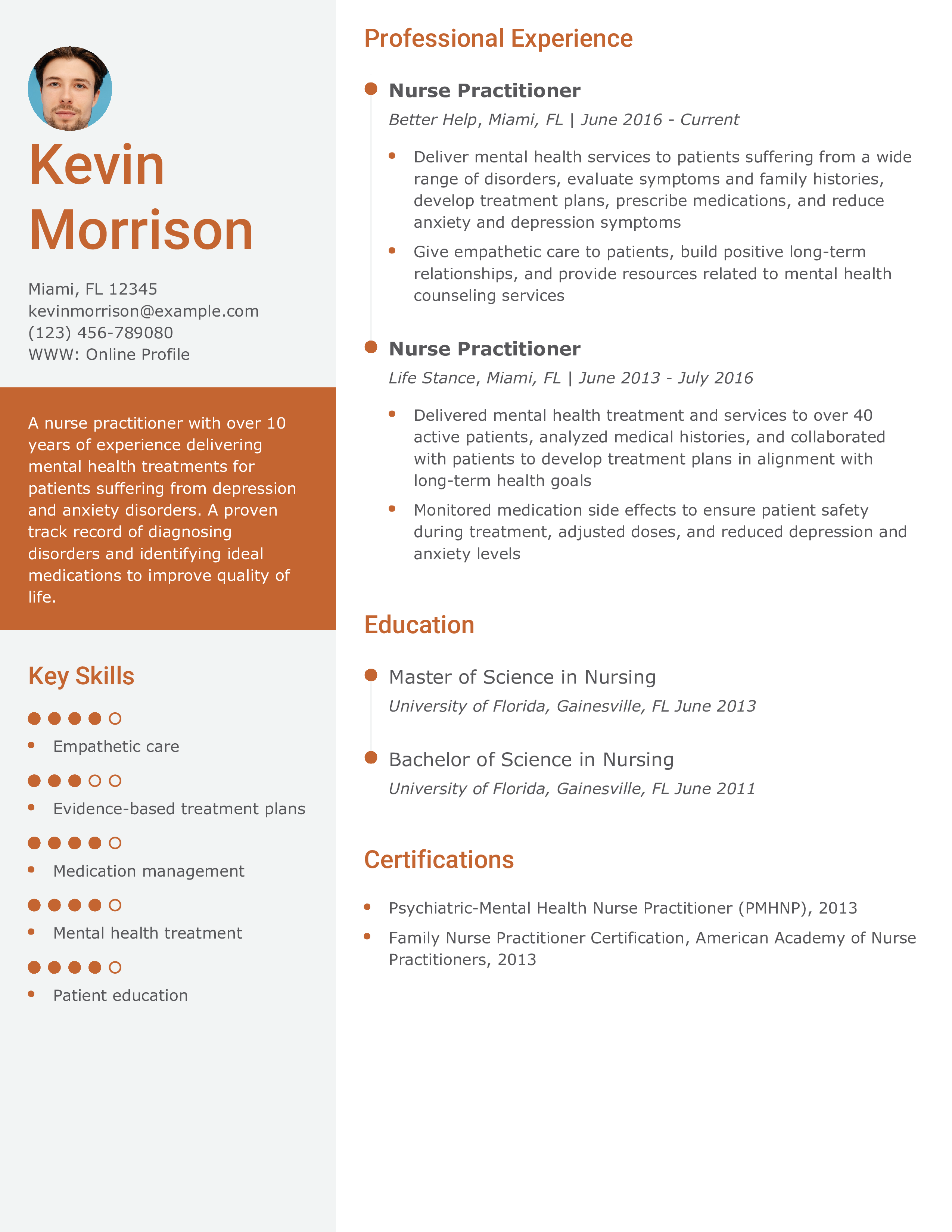
Why this nurse practitioner resume example is strong:
This nurse practitioner resume includes information on the candidate’s many certifications and their education after providing a solid list of their professional experiences.
Nursing Assistant Resume
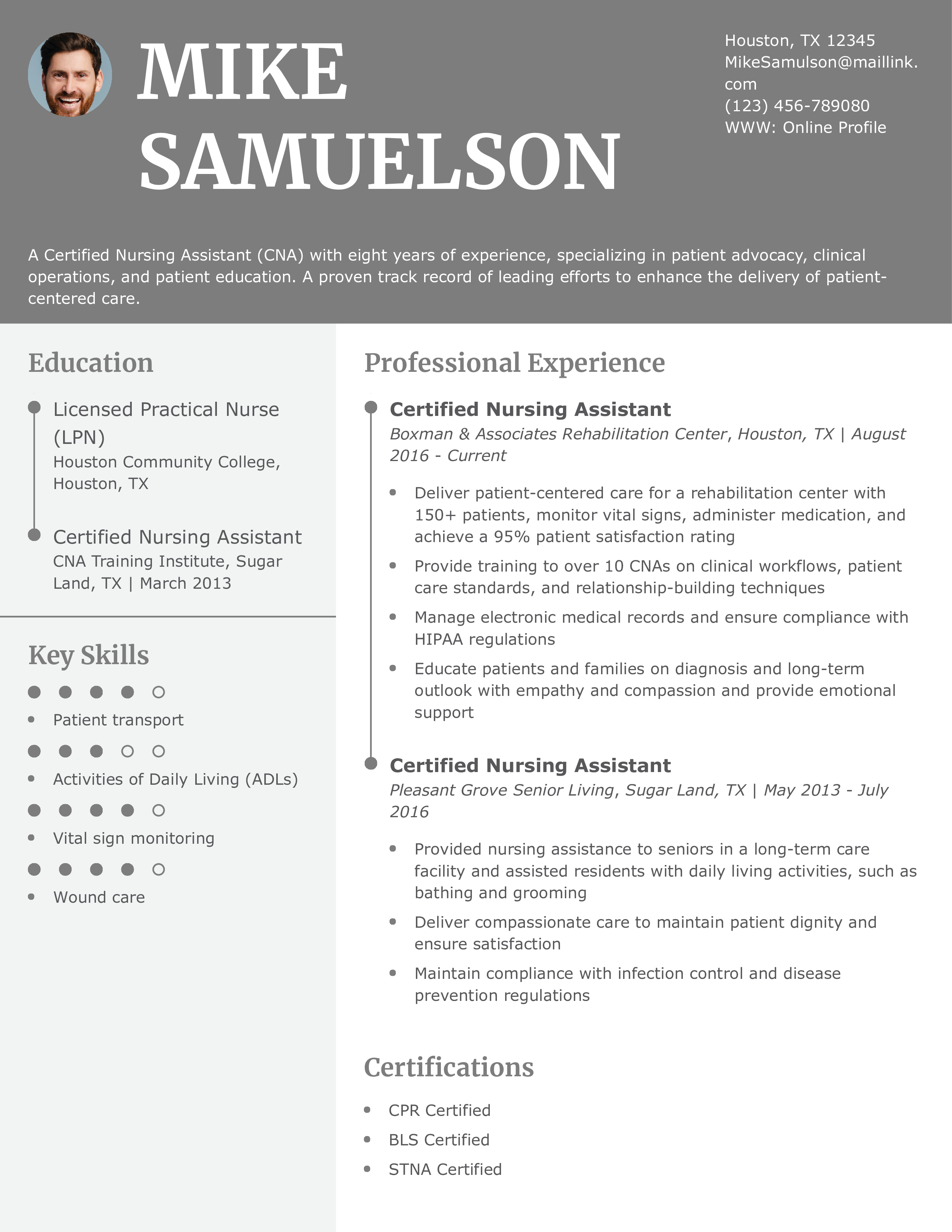
Why this nursing assistant resume example is strong:
This resume utilized separate section headings to highlight the candidate’s education, key skills, and certifications, allowing a hiring manager to scan the document for the necessary key words quickly.
Nurse Resume
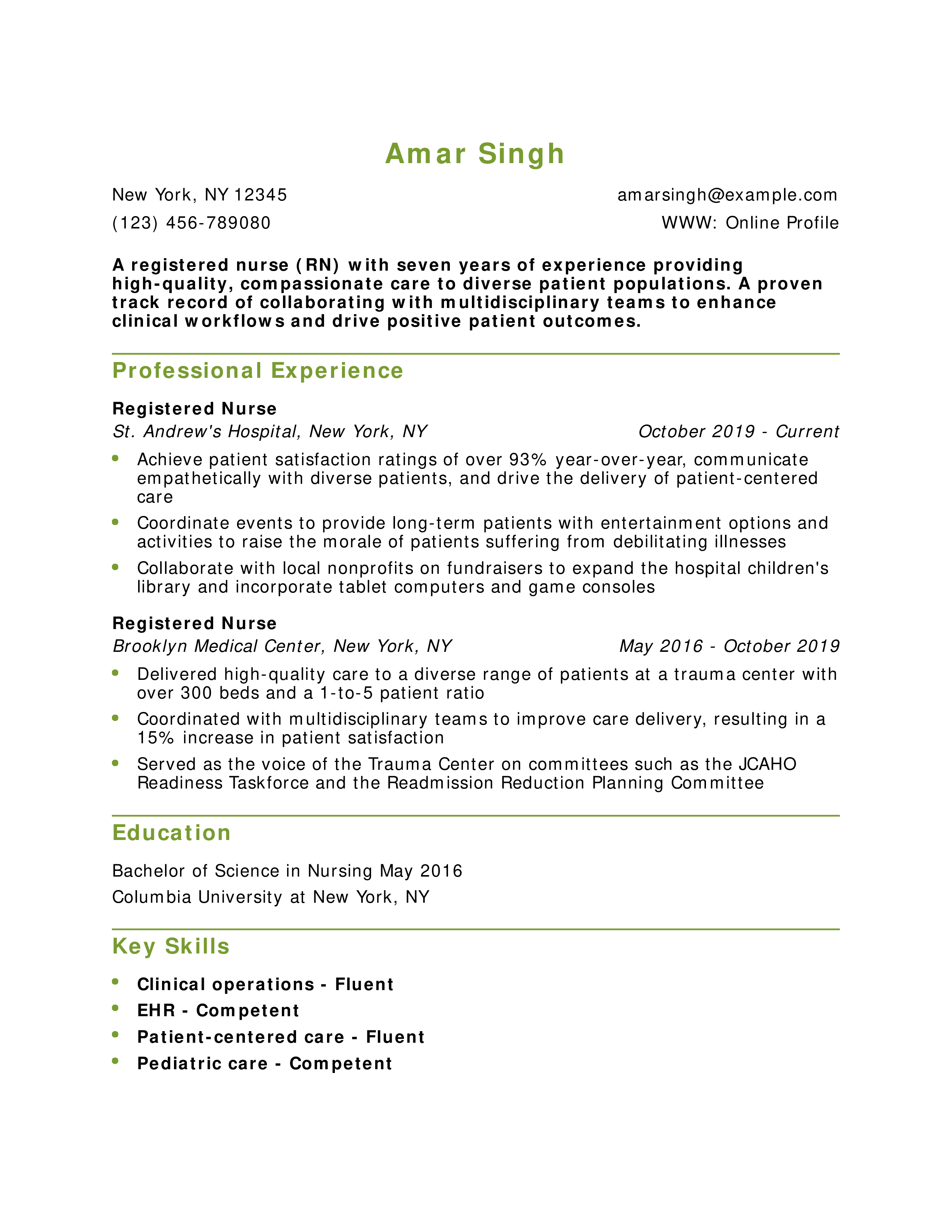
Why this nurse resume example is strong:
The profile section of this nurse resume leads with the candidate’s status as an RN with seven years of experience, which gives hiring managers key information right away. This resume continues by illustrating the type of experience the candidate has using concrete statistics about their past work accomplishments.
Nursing Student Resume

Why this nursing student resume example is strong:
Even though this nursing student is an entry-level candidate, they have professional experience as required by their schooling process, which allows them to lead with that before showcasing their certifications, skills, and education.
Cardiology Nurse Practitioner Resume
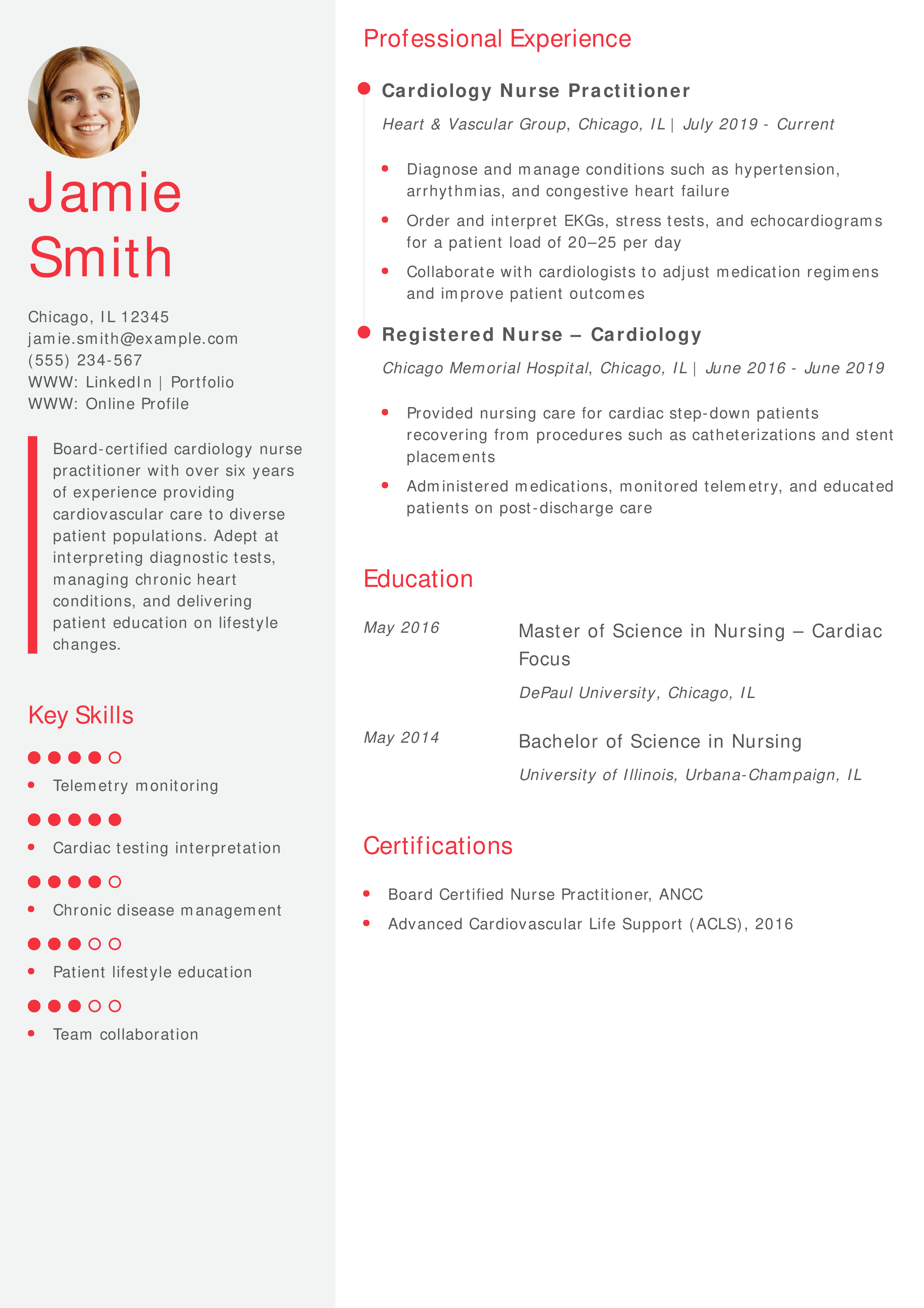
Why This Resume Is a Great Example
Jamie Smith’s resume demonstrates specialized expertise in cardiology while highlighting measurable clinical experience and collaboration with physicians.
Key Tips
Specialized experience should be clearly outlined. For guidance on effective structure, see Resume Outline Examples.
Neonatal Nurse Practitioner Resume
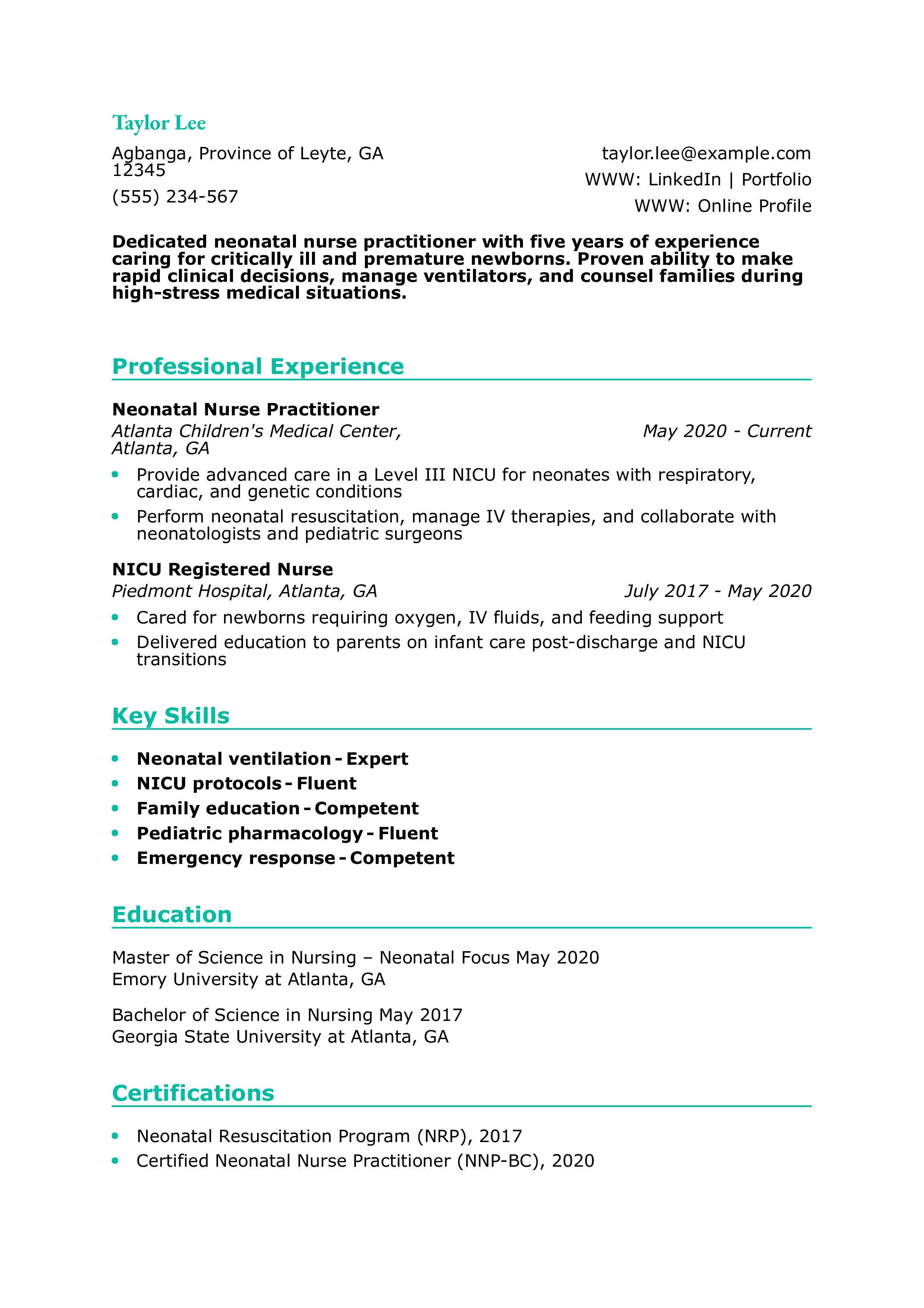
Why This Resume Is a Great Example
Taylor Lee’s resume outlines neonatal-specific responsibilities and certifications that are essential to this high-intensity specialty.
Key Tips
For specialized fields, highlight relevant credentials early. For more tips, visit Resume Certifications.
Aesthetic Nurse Practitioner Resume
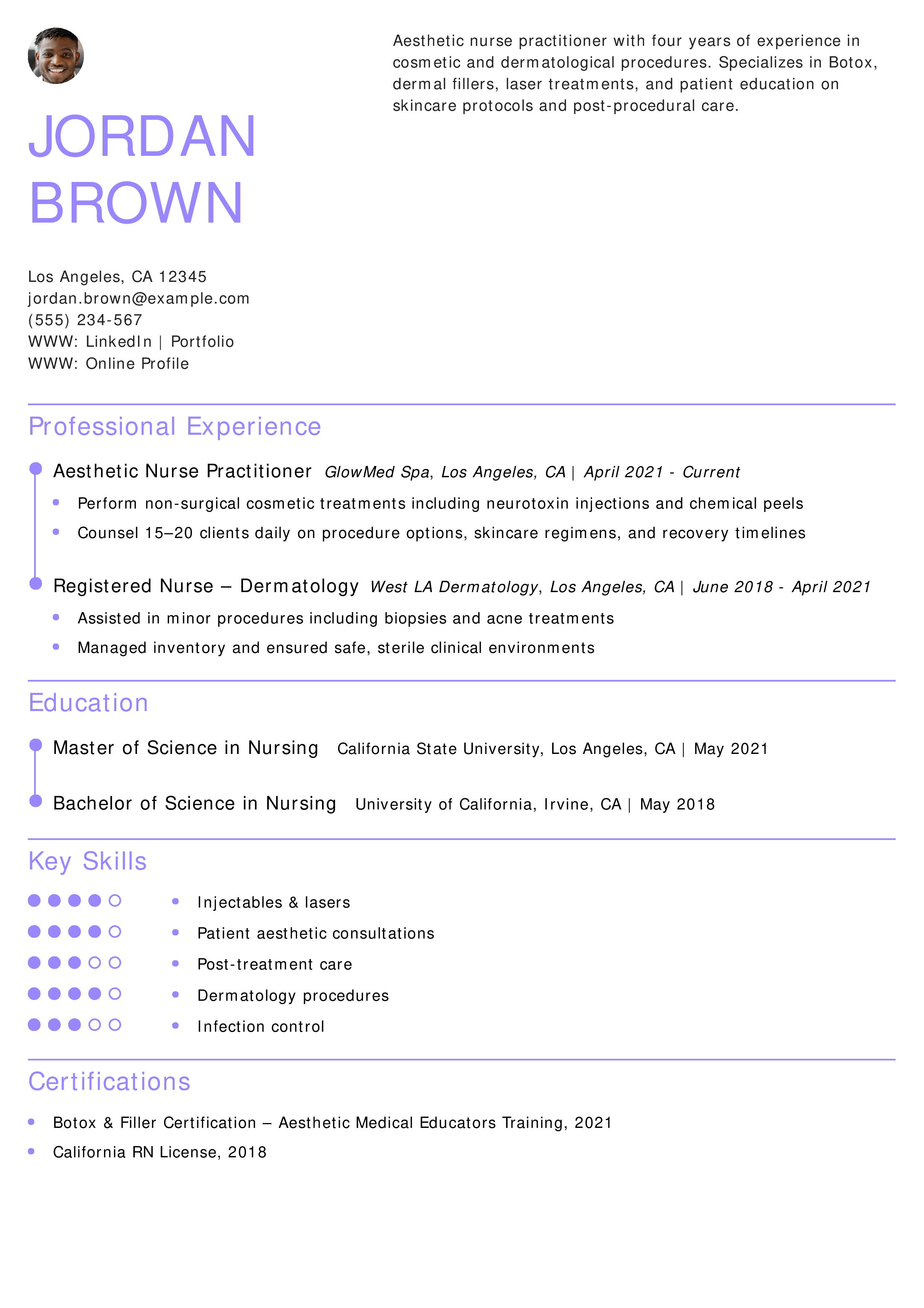
Why This Resume Is a Great Example
Jordan Brown’s resume reflects the skills, licensing, and personal consultation experience needed in aesthetic practice.
Key Tips
Include specific procedures and tools used. For formatting guidance, check out Best Resume Formats.
Internal Medicine Nurse Practitioner Resume

Why This Resume Is a Great Example
Morgan Davis’s resume highlights long-term care experience, which is crucial in internal medicine roles.
Key Tips
Mention chronic conditions you've managed to show scope of responsibility. Learn more at How to Make a Resume.
Oncology Nurse Practitioner Resume
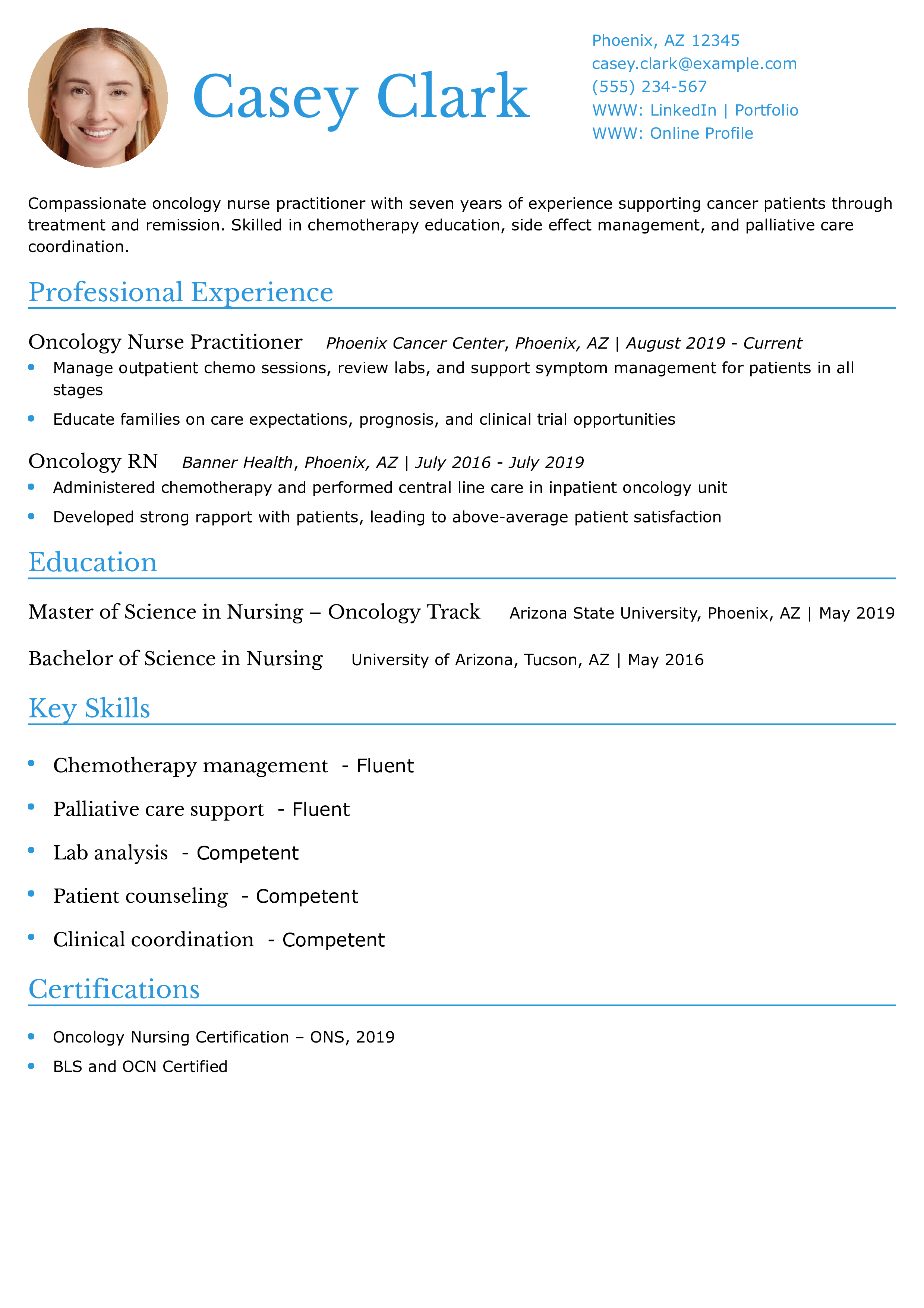
Why This Resume Is a Great Example
Casey Clark’s resume blends technical competence with compassionate care, a must-have in oncology settings.
Key Tips
Highlight emotionally sensitive skills when relevant. For more ideas, check out Soft Skills for a Resume.
Women’s Health Nurse Practitioner Resume
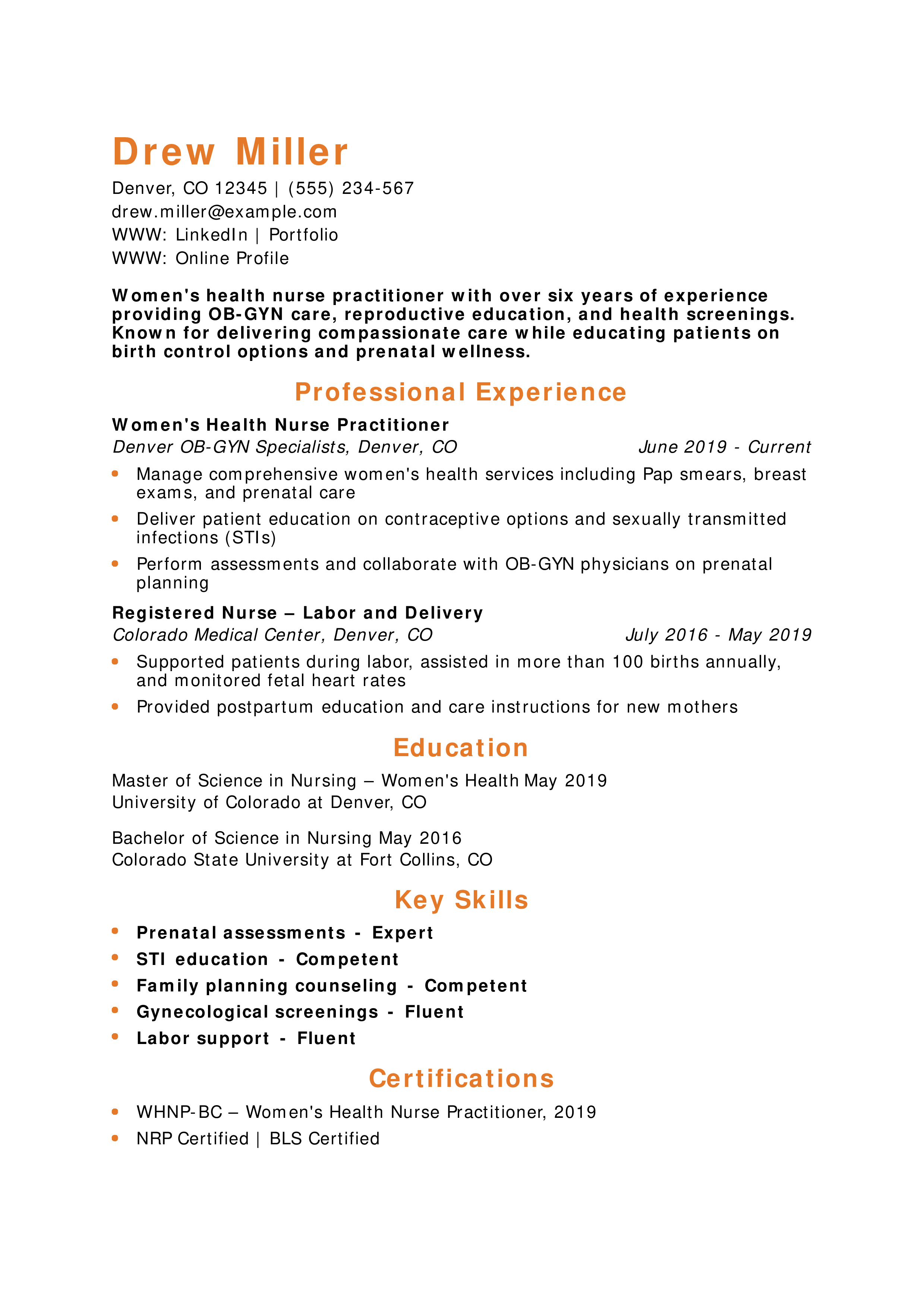
Why This Resume Is a Great Example
Drew Miller’s resume showcases a specialty in women’s health with a clear transition from L&D nurse to WHNP.
Key Tips
Make career progression obvious. Learn more about writing career-focused summaries at Resume Summary Examples.
Travel Nurse Resume
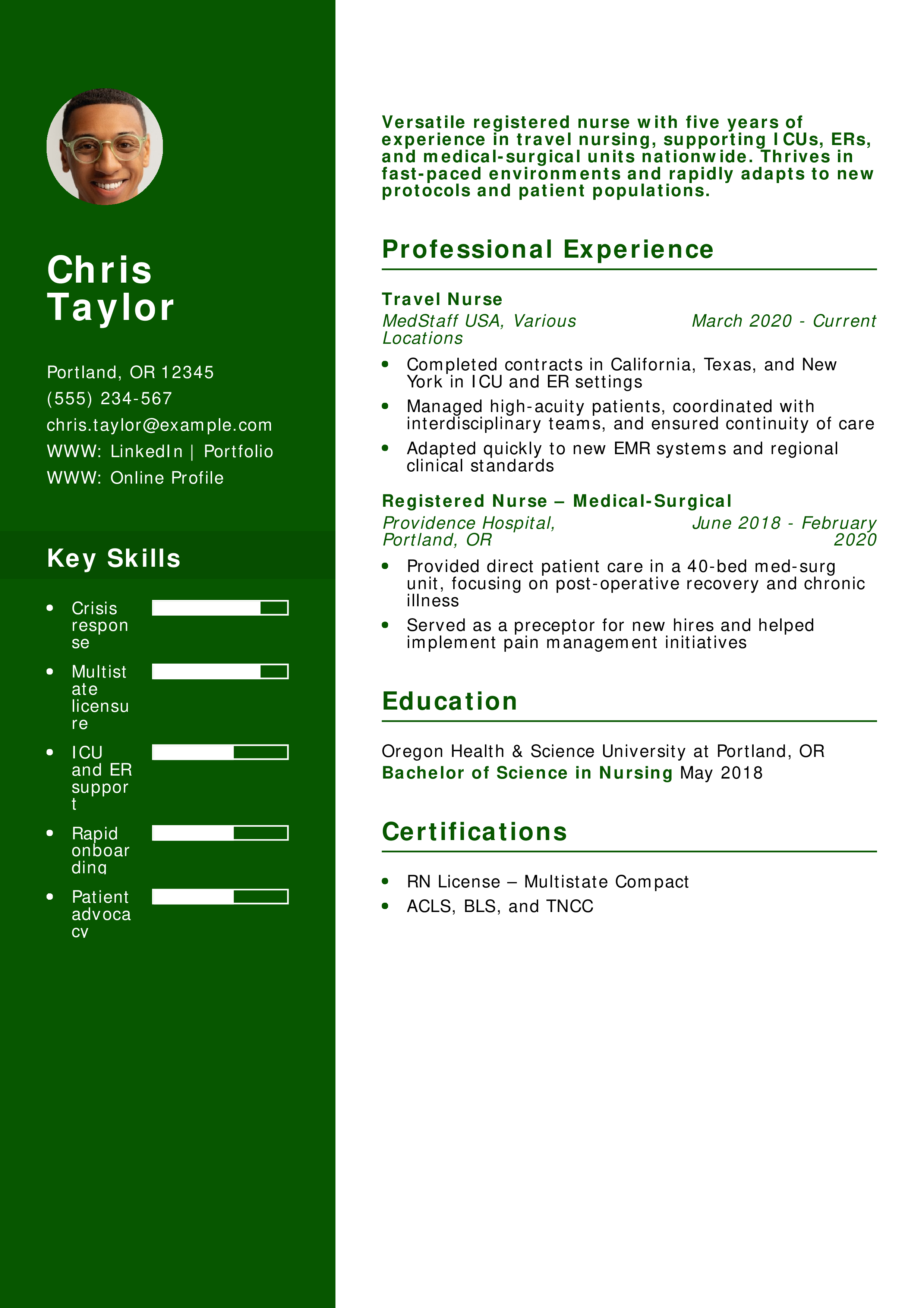
Why This Resume Is a Great Example
Chris Taylor’s resume effectively showcases adaptability and experience across multiple specialties.
Key Tips
Use your profile to emphasize flexibility and reliability. Explore additional tips at What to Put on a Resume.
School Nurse Resume
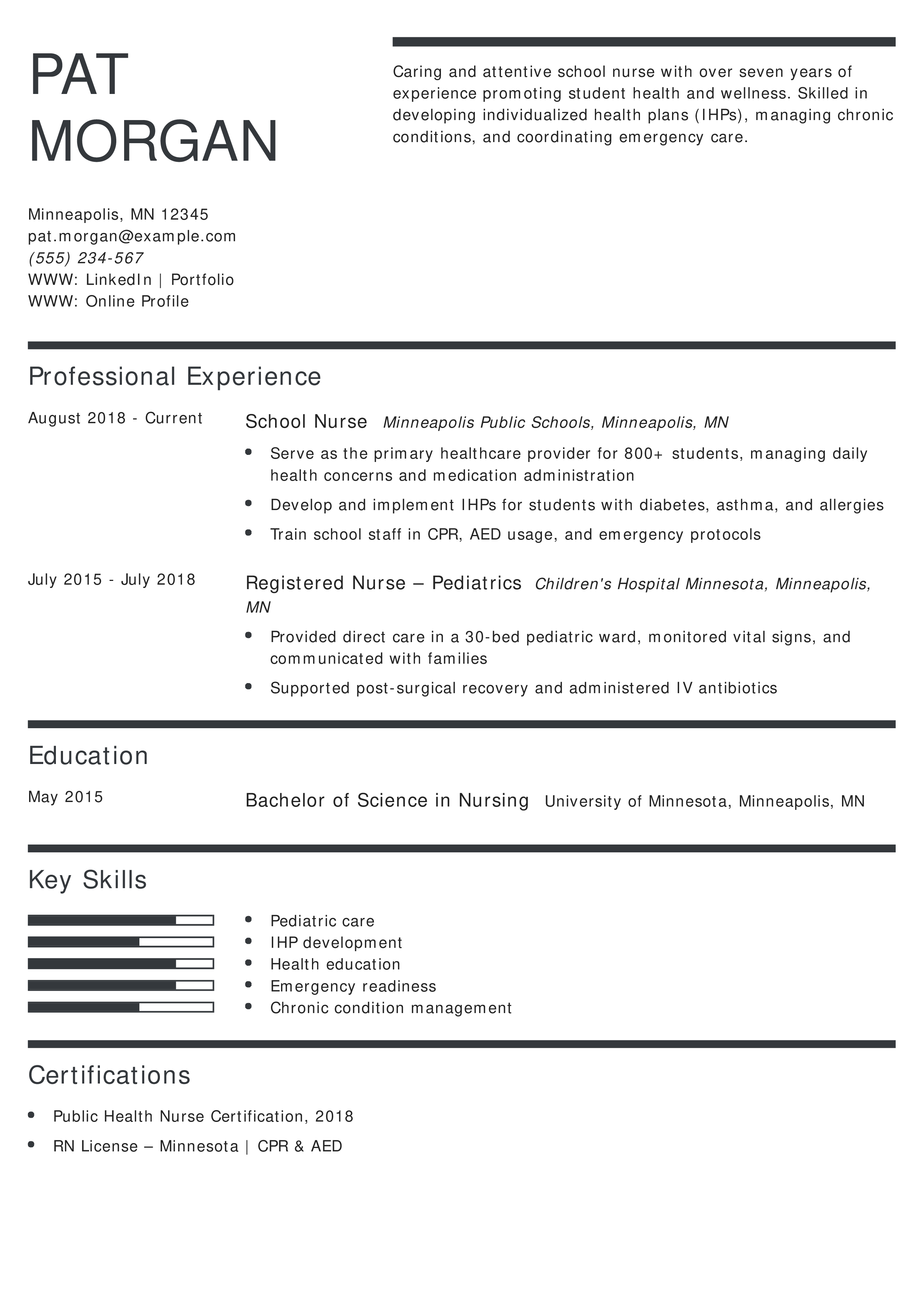
Why This Resume Is a Great Example
Pat Morgan’s resume emphasizes both clinical knowledge and educational outreach skills crucial for school environments.
Key Tips
Tailor your resume to reflect niche settings like schools. See more examples in Resume Skills.
Nurse Case Manager Resume
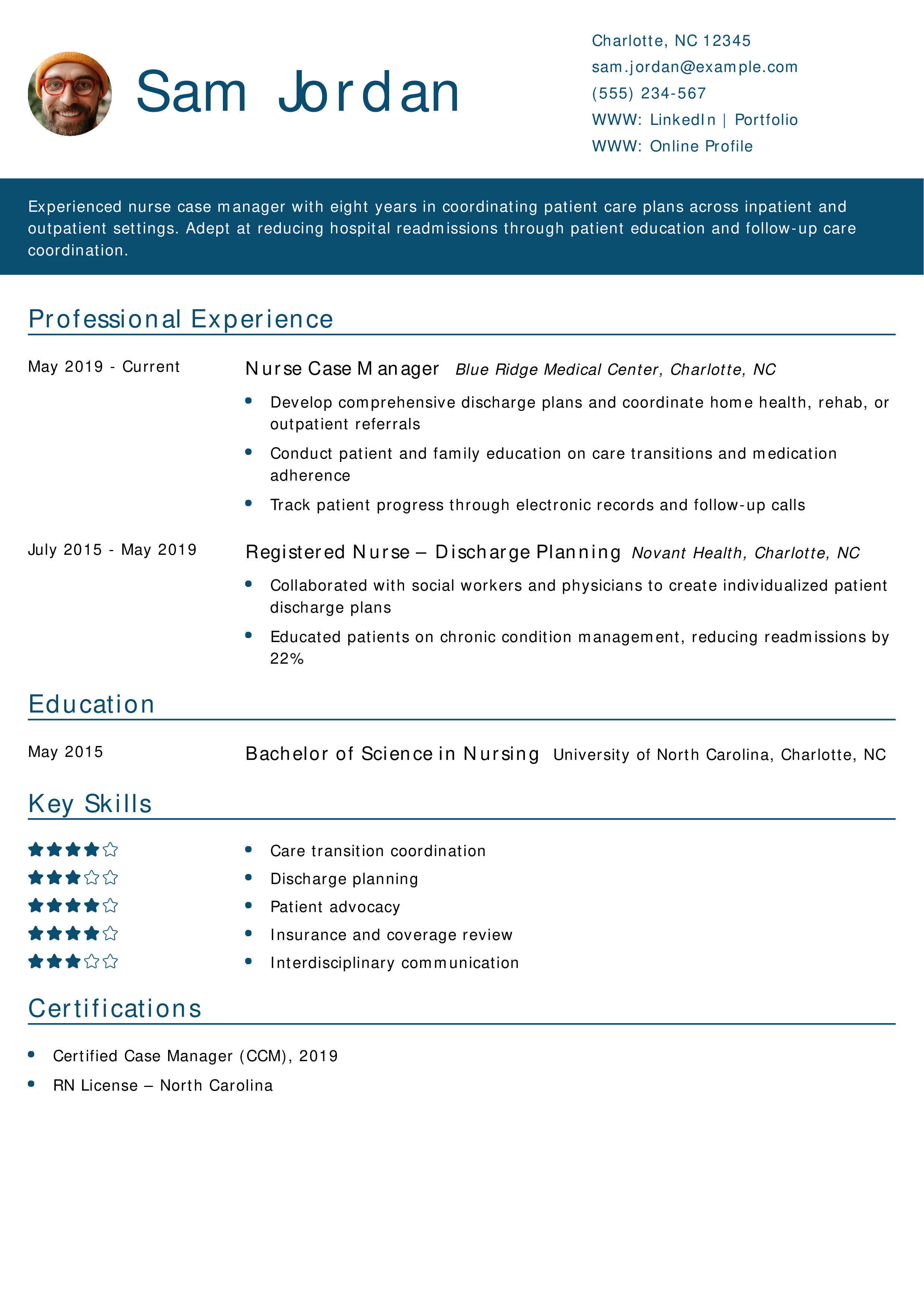
Why This Resume Is a Great Example
Sam Jordan’s resume is structured around measurable results and targeted skills in discharge planning and patient care.
Key Tips
Highlight quantifiable impact where possible. For more advice, visit How to Make a Resume.
Nurse Educator Resume

Why This Resume Is a Great Example
Jamie Smith’s resume blends academic and clinical training experiences to show readiness for both educational and staff development roles.
Key Tips
Use section headers to highlight education-specific roles. For layout inspiration, see Best Resume Formats.
Cardiac Nurse Practitioner Resume
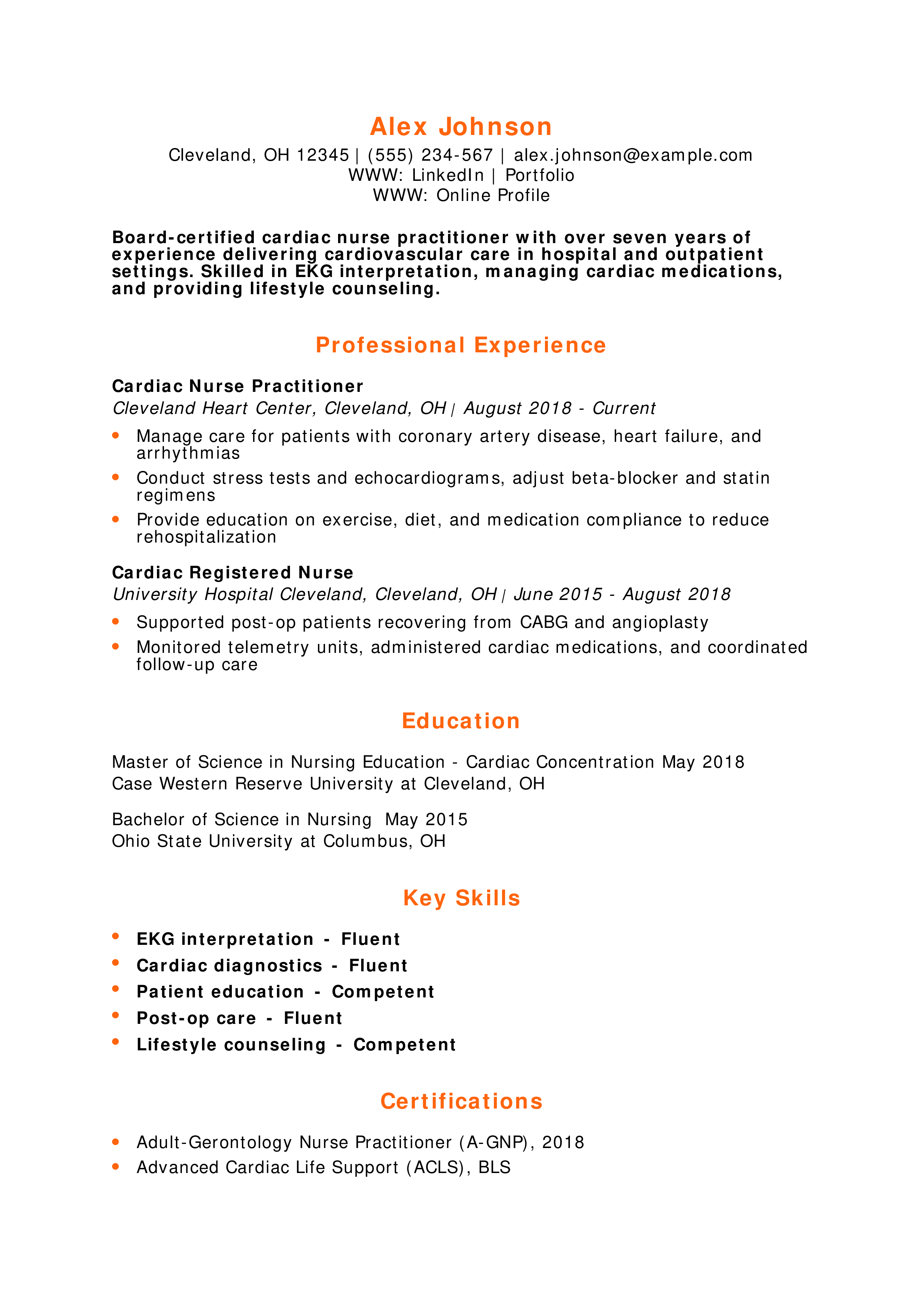
Why This Resume Is a Great Example
Alex Johnson’s resume features a clear career path from cardiac RN to cardiac NP, supported by strong technical competencies.
Key Tips
Use niche terminology to reflect expertise. For more advice, explore Resume Language Skills.
Pain Management Nurse Practitioner Resume
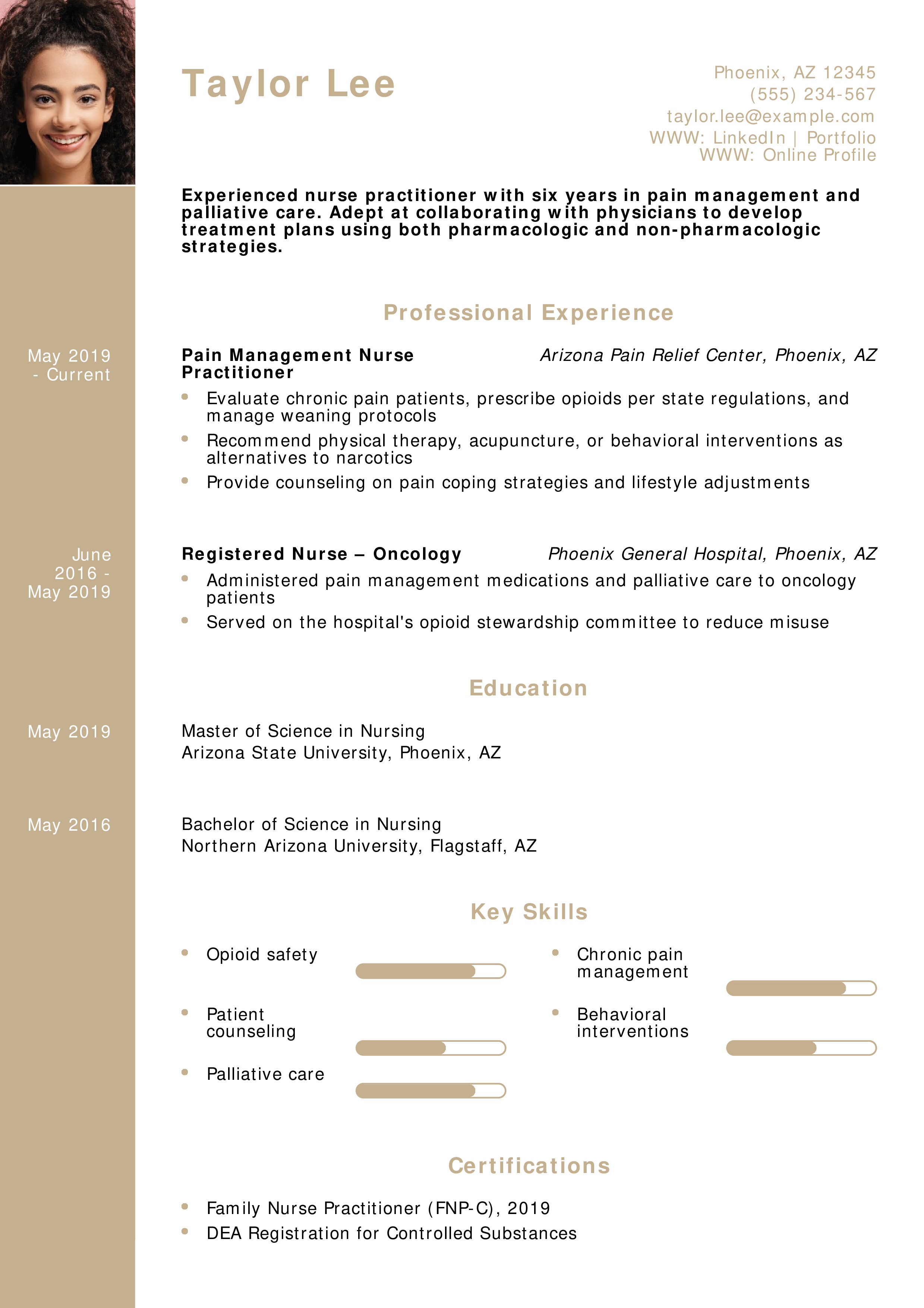
Why This Resume Is a Great Example
Taylor Lee’s resume is centered around a specialty that requires regulatory awareness and patient-centered decision-making.
Key Tips
Tailor your certifications to match your specialty. Learn how in How to List Certifications on Resume.
Geriatric Nurse Practitioner Resume
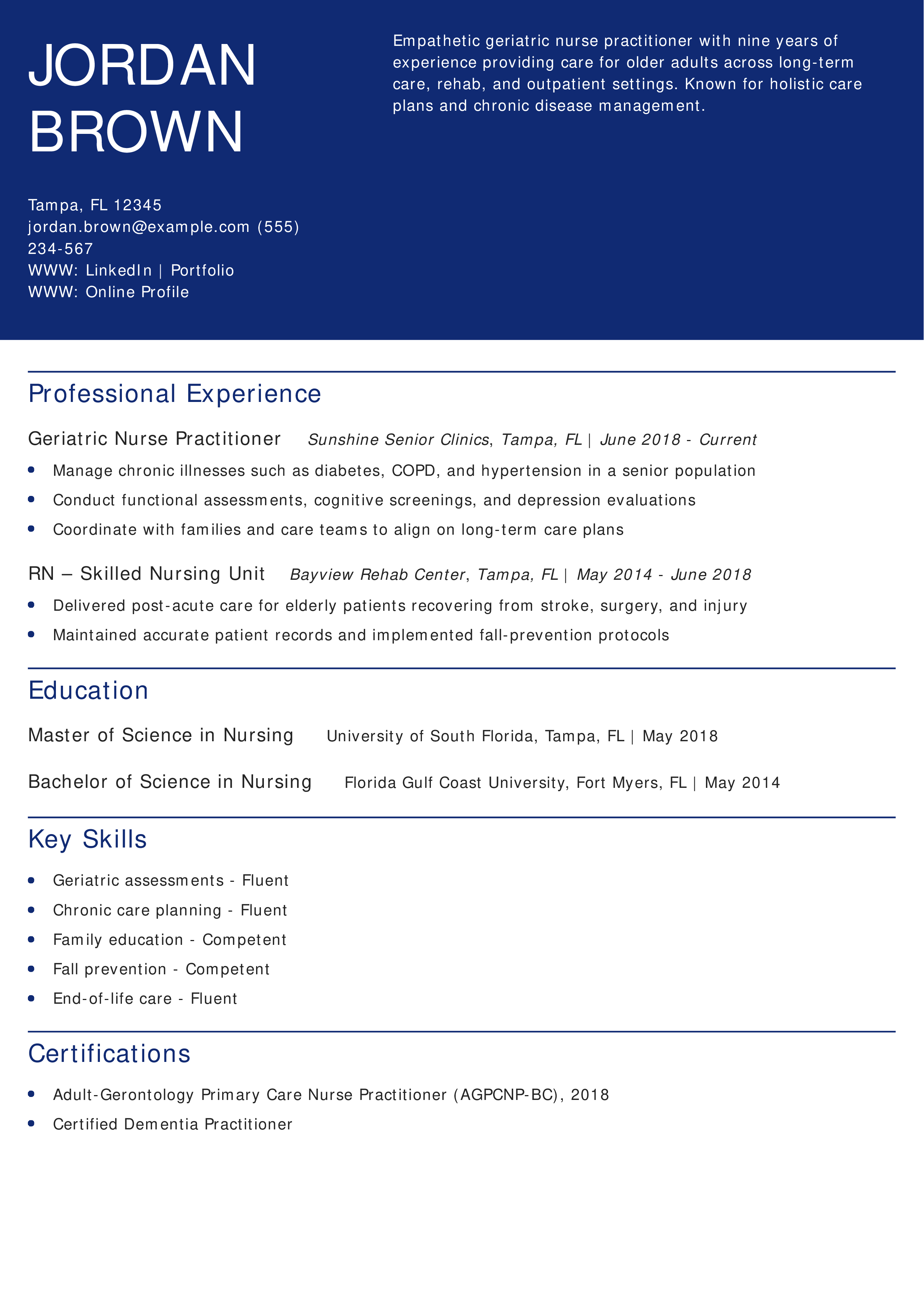
Why This Resume Is a Great Example
Jordan Brown’s resume demonstrates a long-standing focus on senior care with attention to family communication and chronic disease support.
Key Tips
Highlight population-specific skills. For more guidance, visit Soft Skills for a Resume.
Occupational Health Nurse Resume

Why This Resume Is a Great Example
Jordan Brown’s resume is tailored for a non-hospital setting and showcases a str
Key Tips
Highlight compliance skills for corporate healthcare roles. For more guidance, visit Resume Skills.
NICU Nurse Practitioner Resume
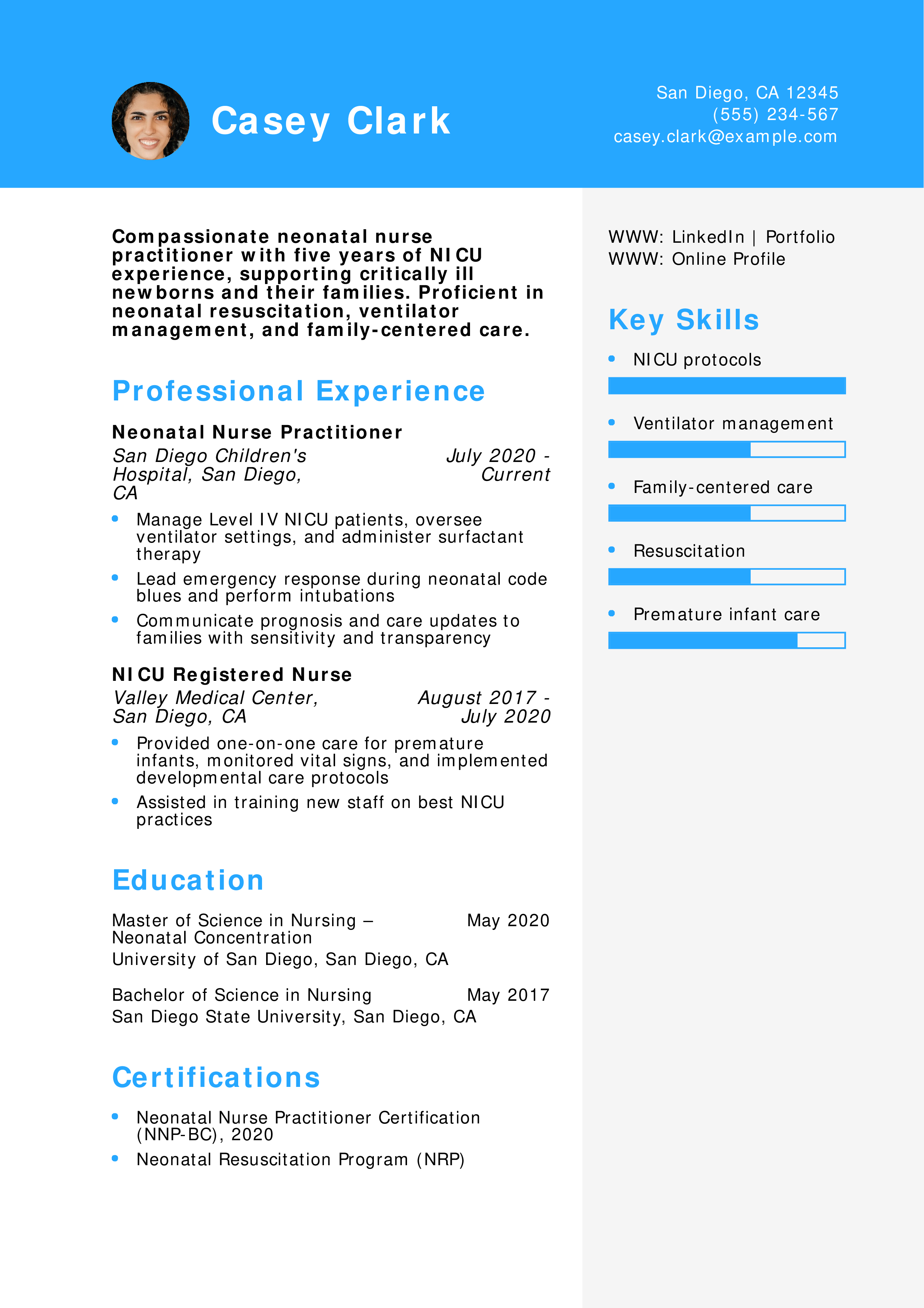
Why This Resume Is a Great Example
Casey Clark’s resume clearly shows NICU specialization and high-stakes technical ability.
Key Tips
Showcase setting-specific skills clearly. For layout ideas, review Best Font for Resume.
Family Nurse Practitioner Resume
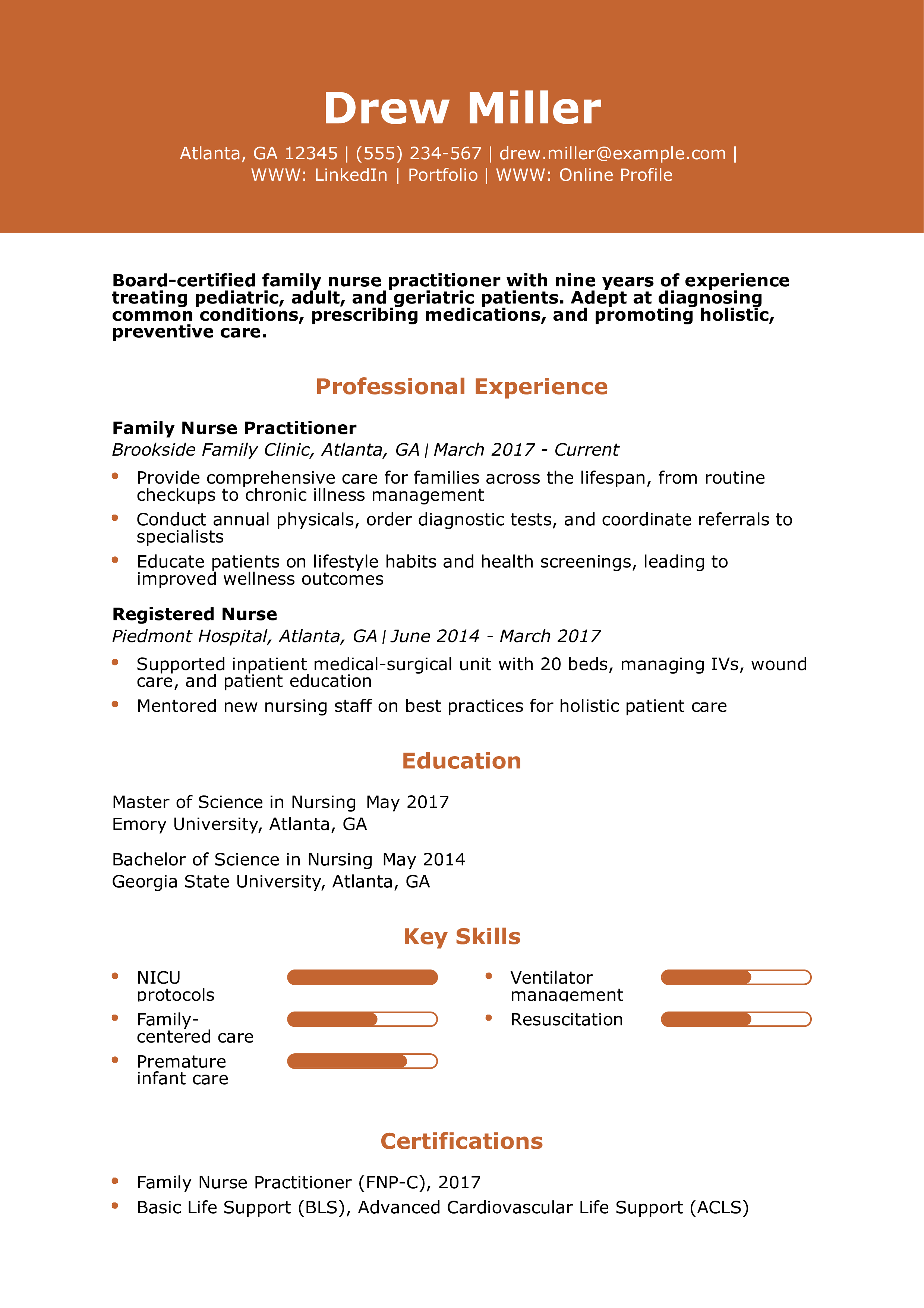
Why This Resume Is a Great Example
Drew Miller’s resume demonstrates longevity and versatility across diverse patient populations in primary care.
Key Tips
Include a wide range of services you provide. For formatting guidance, visit What to Put on a Resume.
Telehealth Nurse Practitioner Resume
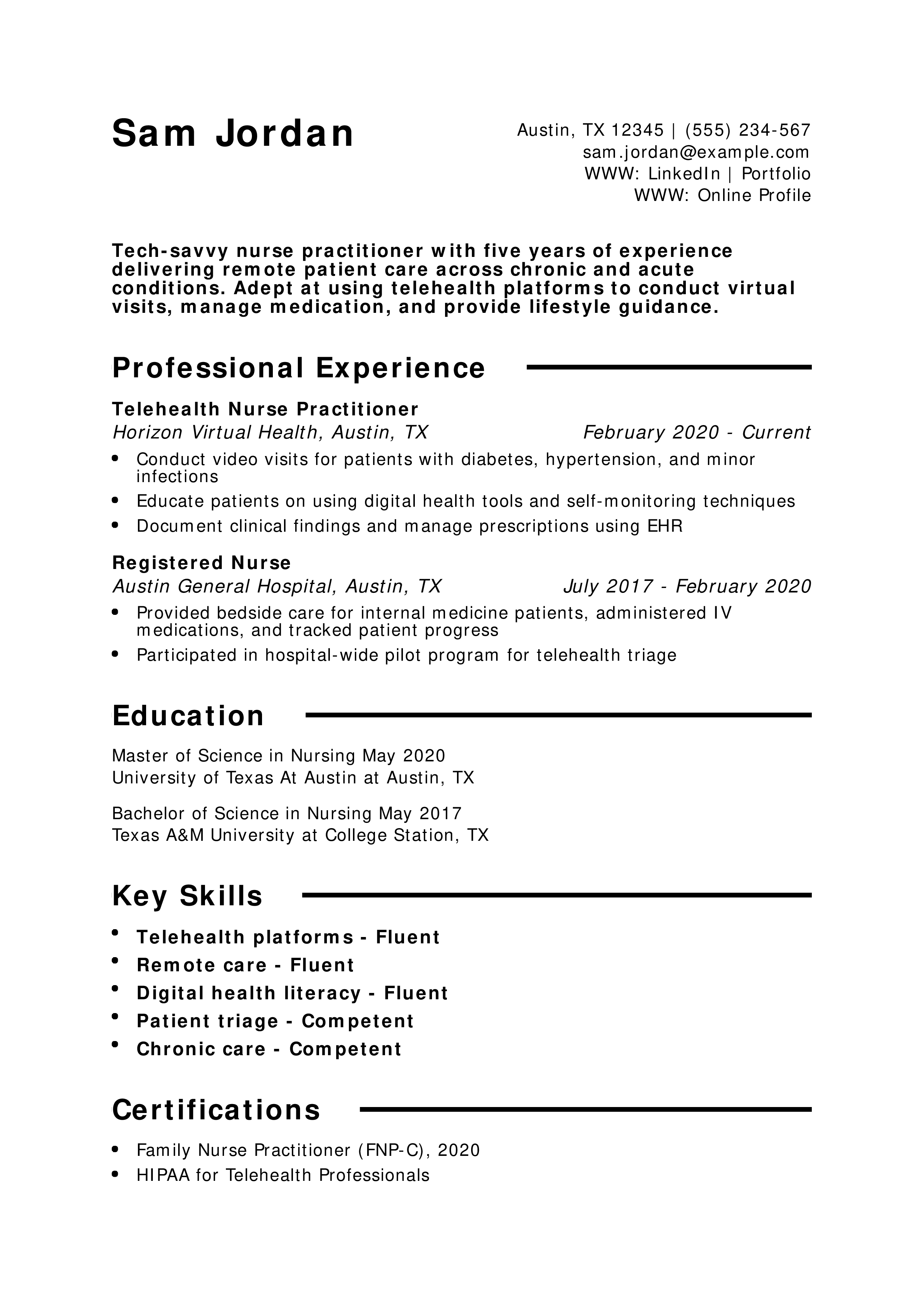
Why This Resume Is a Great Example
Sam Jordan’s resume shows how nursing roles are evolving with technology and highlights comfort with remote platforms.
Key Tips
Mention tech skills explicitly for digital roles. For more advice, check out Technical Skills for Resume.
Acute Care Nurse Practitioner Resume
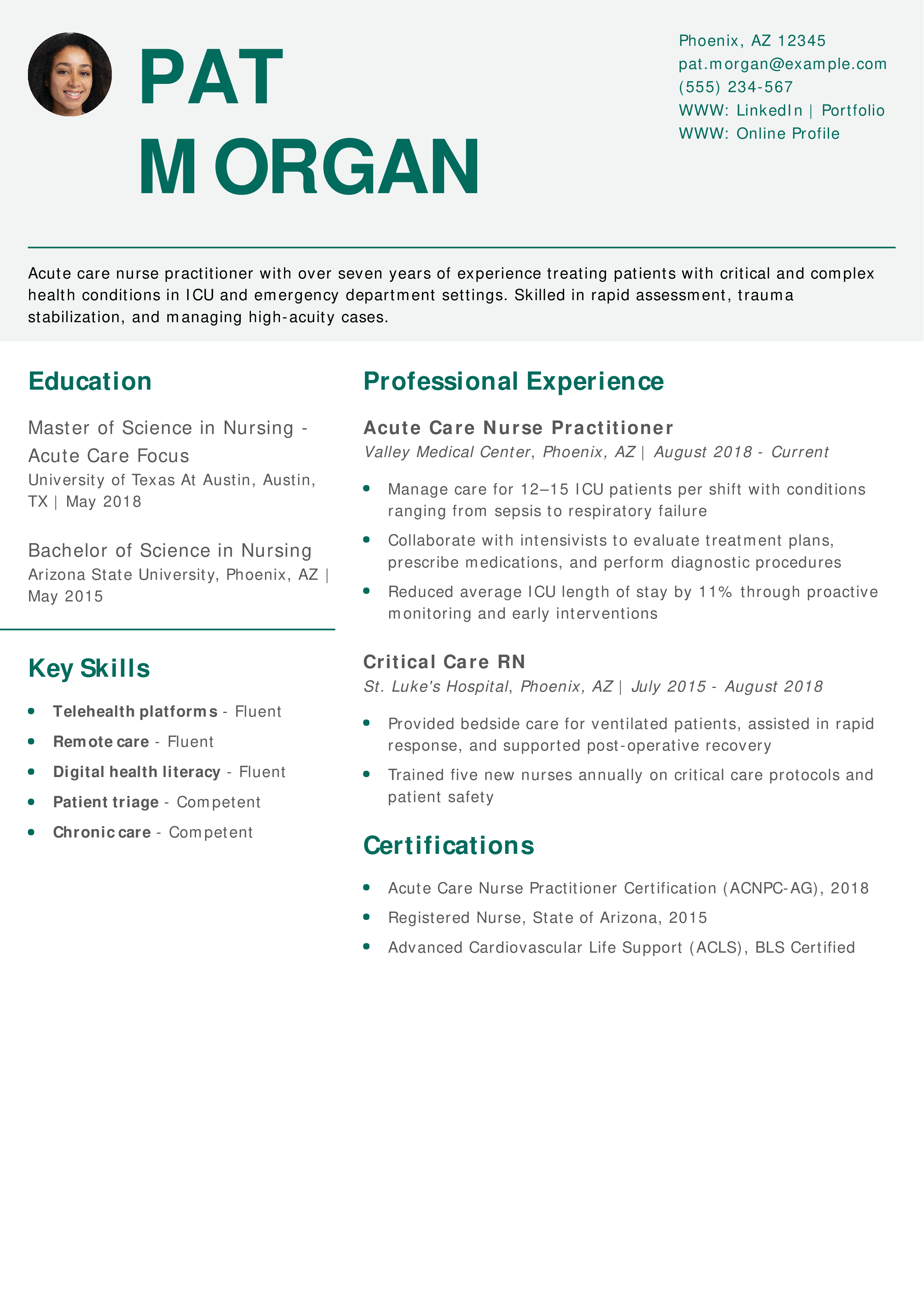
Why This Resume Is a Great Example
Pat Morgan’s resume clearly communicates the ability to handle high-acuity cases, which is crucial for acute care roles.
Key Tips
Include quantifiable outcomes for complex patient care. Learn how to present your results with How to Make a Resume.
Home Health Nurse Practitioner Resume

Why This Resume Is a Great Example
Drew Miller’s resume emphasizes self-direction and patient education—two traits essential for success in home health roles.
Key Tips
Show how you reduce costs or readmissions with data. For more ideas, visit How to Put Volunteer Work on a Resume.
Our templates are crafted by professional resume writers to make creating your resume quick, easy, and effective.
- Professional resume template downloads
- Customized cover letter generation
- AI resume writing support
- Career-building resources and advice
Nurse Practitioner Text-Only Resume Templates and Examples
How To Write a Nurse Practitioner Resume
1. Summarize your nurse practitioner qualifications in a dynamic profile
A professional profile is meant to give a brief overview of your career and areas of expertise to catch the attention of hiring managers. Focus on providing insights into your areas of expertise within the health care industry. For example, if you were a psychiatric mental health nurse practitioner, you’d highlight your ability to treat specific types of mental disorders. If you specialize in pediatric care, draw attention to your years of experience working in those types of units. Remember, the summary is the first thing the hiring manager sees on the resume, so make a strong first impression.
Nurse Practitioner Profile Example 1
Profile
A patient-focused nurse practitioner with seven years of experience delivering compassionate care to diverse patient populations. A proven track record of serving as a patient advocate to enhance the quality of health care standards and services.
Nurse Practitioner Profile Example 2
Profile
A nurse practitioner with over 10 years of experience delivering mental health treatments for patients suffering from depression and anxiety disorders. A proven track record of diagnosing disorders and identifying ideal medications to improve quality of life.
2. Showcase your nurse practitioner experience
As you craft your professional experience, draw attention to your strongest career achievements as a health care provider. When possible, incorporate metrics to strengthen the impact of your bullet points. For instance, including a 1-to-6 patient-nurse ratio would show prospective employers you can work effectively in high-volume clinical settings. As you build out this section, focus on including eye-catching accomplishments that will differentiate you from the crowded field of applicants.
Nurse Practitioner Professional Experience Example 1
Professional Experience
Nurse Practitioner, Central Hospital, Seattle, WA
October 2018 – present
- Provide treatment to over 120 patients per week in a hospital with a 1-to-5 patient ratio, conduct physical examinations, and analyze patient medical histories to diagnose acute and chronic conditions and develop appropriate treatment plans
- Deliver counseling sessions to 30 patients per month to provide education on nutrition, exercise regimen, health care risks, and disease prevention
- Treat patients undergoing hysterectomies, carotid endarterectomies, bypasses, and other surgical procedures
Nurse Practitioner Professional Experience Example 2
Professional Experience
Nurse Practitioner, Johnson & Taylor Medical Offices, Nashville, TN
July 2017 – Present
- Perform assessments for pediatric patients ranging from newborns to patients 21 years of age and manage chronic illnesses, acute conditions, and injuries
- Deliver empathetic and compassionate care to over 22 patients per day, build rapport and long-term relationships, and achieve patient satisfaction ratings of 91% to 94%
- Prescribe medication based on symptoms, age, and medical history, administer vaccinations, and provide education to patients and families
3. Outline your education and nurse practitioner-related certifications
Certifications within the health care space are more important than in most industries. In addition to your credentials, consider exploring optional certifications to include on your resume. This will show hiring managers you’re committed to furthering your medical knowledge and are passionate about delivering the highest quality of patient care. For instance, you could consider obtaining specialty certifications in both acute care and orthopedics to broaden your job opportunities in the open market.
Education
Template
- [Degree Name]
- [School Name], [City, State Abbreviation] [Dates Enrolled]
Example
- Master of Science (B.S.) Nursing
- University of Washington, Seattle, WA September 2014 – June 2016
Certifications
Template
- [Certification Name], [Awarding Organization], [Completion Year]
Example
- Psychiatric-Mental Health Nurse Practitioner (PMHNP), ANCC, 2013
- Family Nurse Practitioner Certification, American Academy of Nurse Practitioners, 2013
4. Outline your most useful nurse practitioner skills and proficiencies
Understanding which keywords hiring managers and Applicant Tracking Systems (ATS) look for when evaluating applications is the first step to creating an effective nurse practitioner resume. The ATS scans for relevant keywords and identifies the most qualified candidates. Integrating keywords that match the job description is an essential part of the resume-building process. Below, you’ll find a list of keywords and skills you may encounter during your job search:
| Key Skills and Proficiencies | |
|---|---|
| Acute care | Case management |
| Clinical workflows | Communication |
| Compassionate care | Disease prevention |
| Evidence-based care | Family medicine |
| Internal medicine | Medication management |
| Mental health | Oncology |
| Orthopedics | Patient assessment |
| Patient care | Patient-centered care |
| Patient education | Pediatric care |
| Prescription management | Treatment planning |
| Wound care | |
5. Highlight patient-centered care and communication skills
As a nurse practitioner, your ability to communicate effectively with patients is essential for the delivery of quality care. Patient advocacy is an important aspect of contemporary health care, so highlight your ability to create treatment plans aligned with the emotional, cultural, and physical needs of patients. Hiring managers value candidates who deliver patient-centered care effectively in diverse clinical environments.
How To Pick the Best Nurse Practitioner Resume Template
As a nurse practitioner, select a well-organized and straightforward template. If your template has bulky graphics or distracting colors, you may draw the hiring manager’s eye away from your health care accomplishments. When in doubt, choose a well-structured template that keeps the reader focused on why you’re qualified for the position rather than just visual appeal.
Frequently Asked Questions: Nurse Practitioner Resume Examples and Advice
What is the best way to highlight my experience in my Nurse Practitioner CV?-
The best way to highlight your experience in your Nurse Practitioner CV is by emphasizing specific achievements in each role. Use bullet points to make your experience scannable and focus on results-driven accomplishments, such as improving processes or saving costs. Include quantifiable data like percentage increases or revenue growth to reinforce the impact of your work.
What are common action verbs for nurse practitioner resumes?-
Many candidates run out of action verbs to use during the resume writing process, especially within the health care industry. In many instances, only a limited number of verbs can describe your clinical experience accurately. Differentiating your usage of action verbs can improve the reading experience and keep your content fresh. We’ve compiled a list of action verbs to craft your resume:
| Action Verbs | |
|---|---|
| Administered | Analyzed |
| Collaborated | Communicated |
| Conducted | Coordinated |
| Delivered | Diagnosed |
| Enhanced | Identified |
| Implemented | Improved |
| Interfaced | Led |
| Managed | Oversaw |
| Performed | Provided |
| Resolved | Supported |
| Treated | |
How do you align your resume with a job description?-
According to the Bureau of Labor Statistics, job openings for nurse practitioners are expected to increase by 46% by 2031, equivalent to around 112,700 new roles. This projected growth is much more rapid than the average 5% growth across all industries. As the average life expectancy increases, more nurse practitioners will be required to provide preventative health care and treat acute and chronic illnesses.
Although job prospects for nurse practitioners are excellent, still align your resume with the description to differentiate yourself from the competition. While it can be tempting to fire off the same resume for every position to save time, doing so could ultimately cause you to miss out. Adapting your resume to mirror each job description is a far more effective way to boost your chances of getting an interview.
What is the best nurse practitioner resume format?-
It is best to always use a reverse chronological format when crafting your nurse practitioner resume. This will ensure that your most recent achievements are featured at the top of your document. Avoid using a functional resume format in most instances, as this approach highlights skill sets without providing context or specific accomplishments for the hiring manager.
How many pages should my nurse practitioner resume be?-
Generally, a nurse practitioner resume should be one page for candidates with fewer than 10 years of experience. A two-page resume is acceptable if you’re a seasoned professional with extensive accomplishments—but only if it provides meaningful details that strengthen your application. Tailor your content to the job, focusing on your most relevant qualifications.
Work history should typically cover the last 10 to 15 years. Older positions can be excluded or briefly summarized unless they’re highly relevant. A concise, focused resume demonstrates your ability to prioritize and communicate effectively.
Craft your perfect resume in minutes
Get 2x more interviews with Resume Builder. Access Pro Plan features for a limited time!

Once you finish crafting your resume, write a matching cover letter. Rather than simply repeating all the existing information from your resume, customize your letter for individual applications. For instance, if you’re applying to a hospital that emphasizes health care equity, you might want to state that your commitment to diversity, equality, and inclusion (DEI) is what draws you to apply for the position. For more help, visit our nursing cover letter guide.




